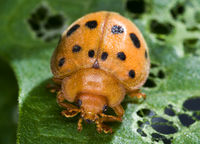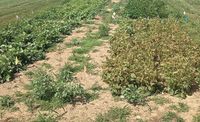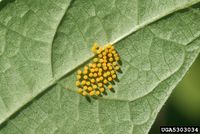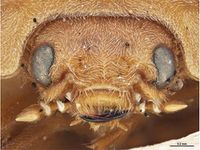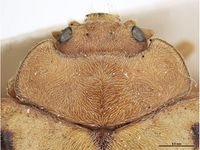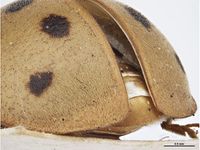Difference between revisions of "Epilachna varivestis"
| (3 intermediate revisions by the same user not shown) | |||
| Line 2: | Line 2: | ||
{{LiteratureDB|{{PAGENAME}}|browse,crops,benefialsN}} | {{LiteratureDB|{{PAGENAME}}|browse,crops,benefialsN}} | ||
[[File:Epilachna_varivestis_IPM1235113.jpg|250px|thumb|''Epilachna varivestis'' adult and larva on soybean (click on image to enlarge it)<br/>Source: [http://www.ipmimages.org/browse/detail.cfm?imgnum=1235113 Clemson University - USDA Cooperative Extension Slide Series - IPM Images]]] | [[File:Epilachna_varivestis_IPM1235113.jpg|250px|thumb|''Epilachna varivestis'' adult and larva on soybean (click on image to enlarge it)<br/>Source: [http://www.ipmimages.org/browse/detail.cfm?imgnum=1235113 Clemson University - USDA Cooperative Extension Slide Series - IPM Images]]] | ||
| − | <font color="#800000">'''''Epilachna varivestis'''''</font> Mulsant - (Mexican bean beetle) | + | <font color="#800000">'''''Epilachna varivestis'''''</font> Mulsant, 1850 - (Mexican bean beetle) |
| − | The beetle is a pest of soybean, beans and other legumes in North America. It is considered to be native to southern Mexico and Guatemala and was accidentally introduced into the U.S.A. (first record in Florida in 1933) and Japan (first record in 1997). Both the adults and the larvae feed in the leaves of legumes, sometimes also on flowers and pods. The larvae are found underneath the leaves and are the most destructive stage. | + | The beetle is a pest of soybean, beans and other legumes in North America. It is considered to be native to higher elevation areas of southern Mexico and Guatemala and was accidentally introduced into the U.S.A. (first record in Florida in 1933) and Japan (first record in 1997). It has spread to most areas in the U.S. and to southern Canada, being most common in the Mid-Atlantic and southern Appalachian Mountain regions. |
| + | |||
| + | Both the adults and the larvae feed in the leaves of legumes, sometimes also on flowers and pods. The larvae are found underneath the leaves and are the most destructive stage. While beans and soybeans can tolerate significant damage to their foliage, the degree of tolerance depends on environmental conditions and these have to be considered when determining threshold levels. | ||
{{VN | {{VN | ||
|de=mexikanischer Bohnenkäfer | |de=mexikanischer Bohnenkäfer | ||
| Line 11: | Line 13: | ||
|es=escarabajo mexicano del frijol | |es=escarabajo mexicano del frijol | ||
}} | }} | ||
| + | Eggs are laid in batches on the leaves and the development from egg to adults lasts around 6 weeks. There can be up to 3 or 4 generations per year. The adults overwinter in plant debris and other locations. Their survival during the winter will again depend on the weather conditions. | ||
| − | + | Cultural management includes the use of reflective plastic mulches, trap crops, resistant cultivars and timing planting the crop either before or after the overwintering adults emerge. Biological control is also recommended, for example releasing the parasitoid ''[[Pediobius foveolatus (parasitoid)|Pediobius foveolatus]]'' which is commercially available. For the use of chemical pesticides, the economic threshold depends on the crop, the growing stage of the crop, as well as the environmental conditions. For example for soybeans, a 40% pre-bloom defoliation level or a 15% level during bloom and pod development might be applicable. | |
| − | + | ||
| − | + | ||
| − | + | ||
| + | The adults are 6-8 mm long, yellowish with 8 dark spots on each elytron arranged in 3 rows. The larvae are bright yellow with black spines. The pupae are also yellowish and are often found in aggregations. | ||
| + | For a review see [[Journal of Integrated Pest Management (2016) 7 (1 - 2), 1-12|Nottingham et al., 2016]]. | ||
| − | <gallery widths=200px caption="Other images of Epilachna varivestis (IPM Images and PaDIL - click to enlarge)"> | + | <gallery widths=200px caption="Other images of Epilachna varivestis (Wikimedia Commons, IPM Images, J. of IPM and PaDIL - click to enlarge)"> |
| + | File:Epilachna varivestis (cropped).jpg | ||
File:Epilachna_varivestis_IPM1235187.jpg|adult and larva on soybean | File:Epilachna_varivestis_IPM1235187.jpg|adult and larva on soybean | ||
| + | File:Epilachna varivestis jipm 2016 2.jpg|damage on wax snap beans (right), left resistant lima bean variety | ||
File:Epilachna_varivestis_IPM5303034.jpg|eggs | File:Epilachna_varivestis_IPM5303034.jpg|eggs | ||
File:Epilachna_varivestis_PaDIL142344a.jpg|head | File:Epilachna_varivestis_PaDIL142344a.jpg|head | ||
Latest revision as of 20:39, 22 April 2019
| Literature database |
|---|
| 100 articles sorted by: |
| • year (recent ones first) |
| • research topics |
| • countries/regions |
| • host plants |
| • list of natural enemies |
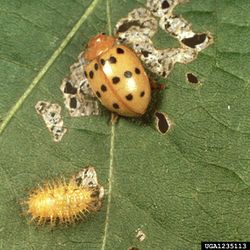
Source: Clemson University - USDA Cooperative Extension Slide Series - IPM Images
Epilachna varivestis Mulsant, 1850 - (Mexican bean beetle)
The beetle is a pest of soybean, beans and other legumes in North America. It is considered to be native to higher elevation areas of southern Mexico and Guatemala and was accidentally introduced into the U.S.A. (first record in Florida in 1933) and Japan (first record in 1997). It has spread to most areas in the U.S. and to southern Canada, being most common in the Mid-Atlantic and southern Appalachian Mountain regions.
Both the adults and the larvae feed in the leaves of legumes, sometimes also on flowers and pods. The larvae are found underneath the leaves and are the most destructive stage. While beans and soybeans can tolerate significant damage to their foliage, the degree of tolerance depends on environmental conditions and these have to be considered when determining threshold levels.
| Vernacular names | |
|---|---|
| • Deutsch: | mexikanischer Bohnenkäfer |
| • English: | Mexican bean beetle |
| • Español: | escarabajo mexicano del frijol |
| • Français: | coccinelle mexicaine des haricots |
Eggs are laid in batches on the leaves and the development from egg to adults lasts around 6 weeks. There can be up to 3 or 4 generations per year. The adults overwinter in plant debris and other locations. Their survival during the winter will again depend on the weather conditions.
Cultural management includes the use of reflective plastic mulches, trap crops, resistant cultivars and timing planting the crop either before or after the overwintering adults emerge. Biological control is also recommended, for example releasing the parasitoid Pediobius foveolatus which is commercially available. For the use of chemical pesticides, the economic threshold depends on the crop, the growing stage of the crop, as well as the environmental conditions. For example for soybeans, a 40% pre-bloom defoliation level or a 15% level during bloom and pod development might be applicable.
The adults are 6-8 mm long, yellowish with 8 dark spots on each elytron arranged in 3 rows. The larvae are bright yellow with black spines. The pupae are also yellowish and are often found in aggregations.
For a review see Nottingham et al., 2016.
- Other images of Epilachna varivestis (Wikimedia Commons, IPM Images, J. of IPM and PaDIL - click to enlarge)
